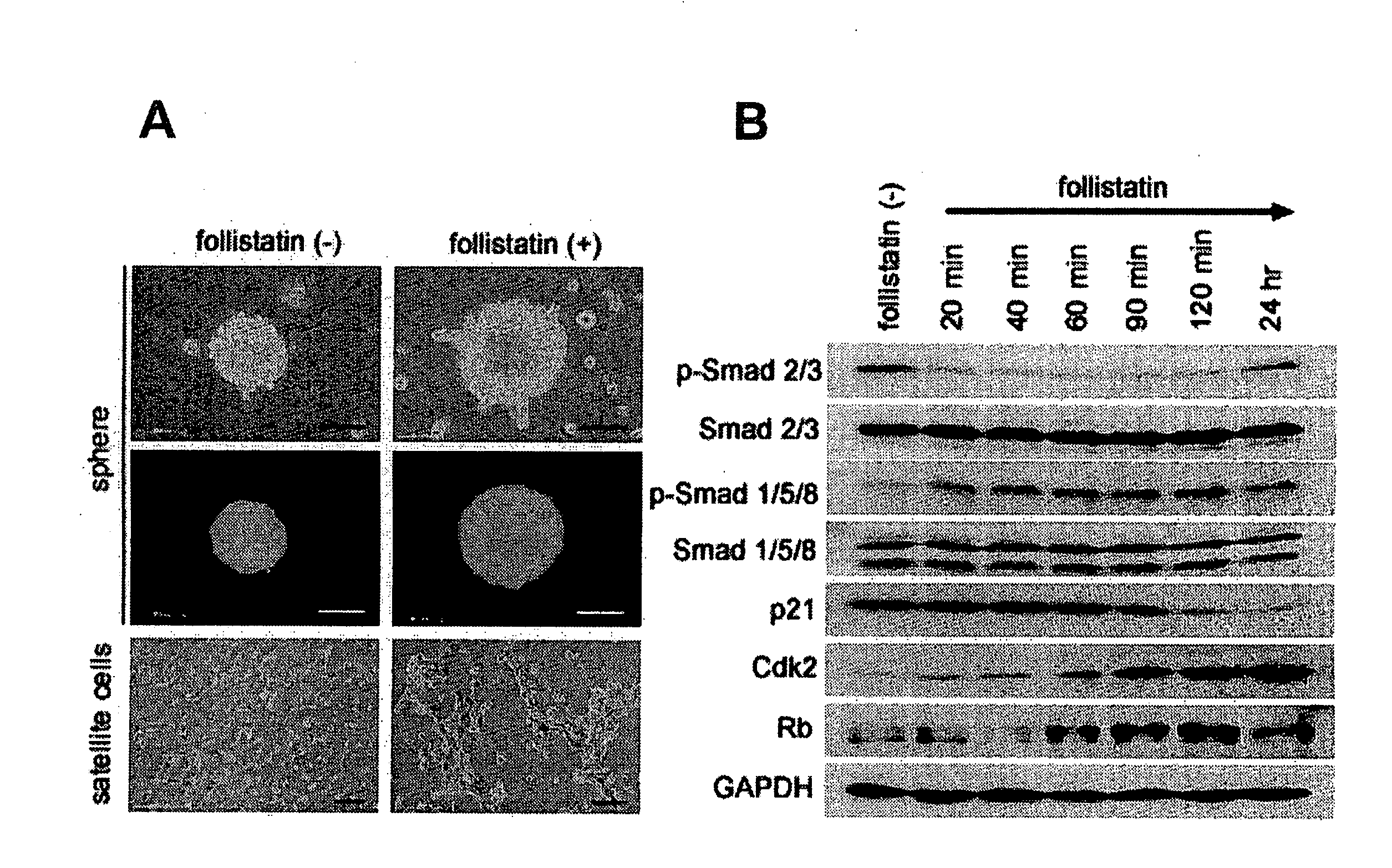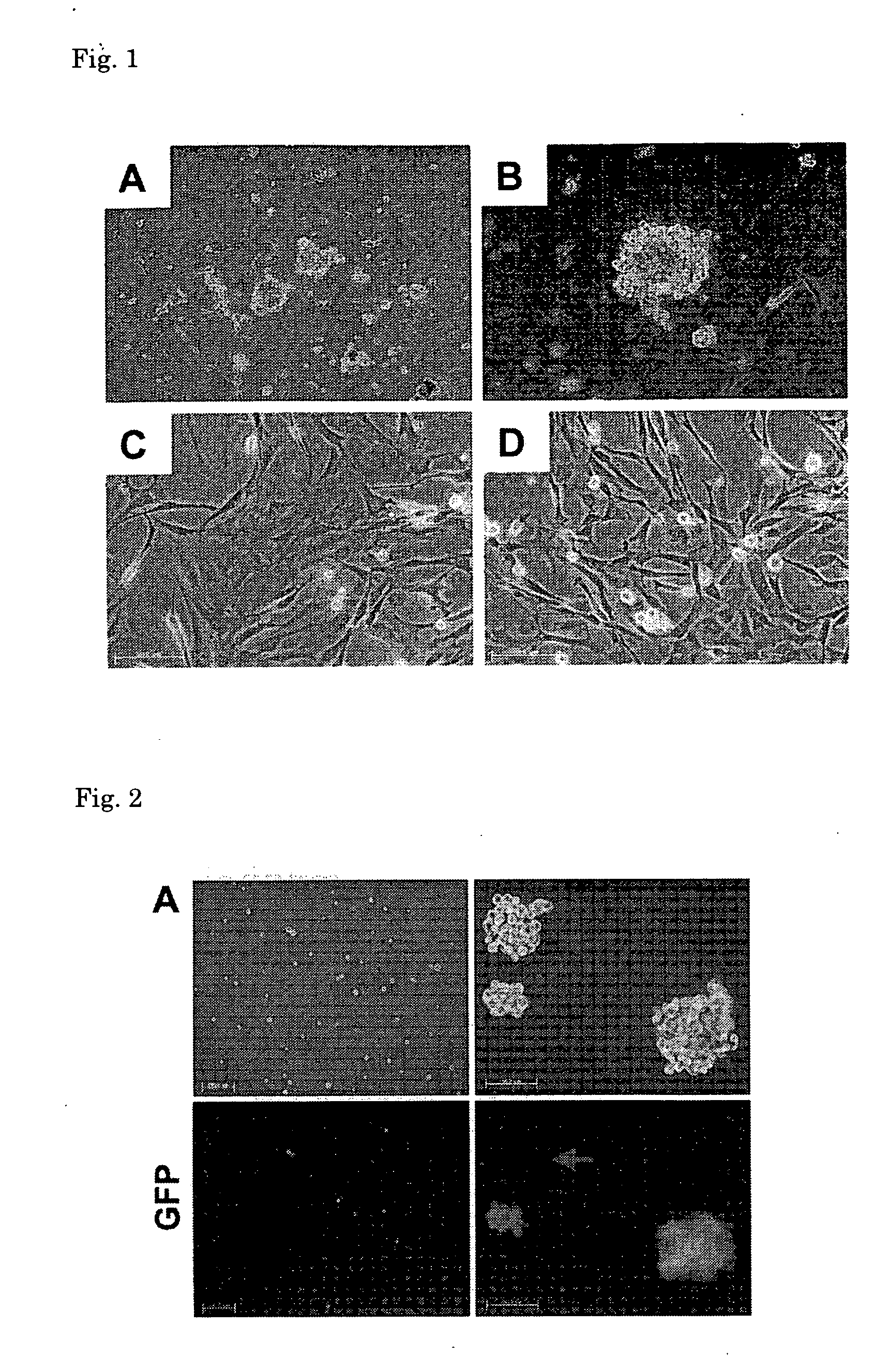Pluripotent Stem Cell Cloned From Single Cell Derived From Skeletal Muscle Tissue
a single cell, pluripotent stem cell technology, applied in the direction of skeletal/connective tissue cells, instruments, drug compositions, etc., can solve the problems of cardiac transplantation, lack of donors, and insufficient therapeutic effect, so as to minimize contamination with different types of cells, high purity, and low purity
- Summary
- Abstract
- Description
- Claims
- Application Information
AI Technical Summary
Benefits of technology
Problems solved by technology
Method used
Image
Examples
example 1
Acquisition of Mouse Skeletal Muscle Tissue-Derived Stem Cell
(1) Acquisition of Mouse Skeletal Muscle Tissue-Derived Cell
[0123]Six- to eight-week-old female C57Bl / 6J mice (available from Shimizu Laboratory Supplies Co., Ltd.) (hereinafter referred to sometimes as wild-type mice) or the same mice endowed with an ability to express a green fluorescence protein (GFP) (hereinafter referred to sometimes as GFP-expressing mice) were euthanized manually by cervical spine dislocation under anesthesia with diethyl ether, and the whole body was antisepticised with 70 vol % of aqueous ethyl alcohol solution. The skin in the lower extremities below the lumbar region was removed with sharp-pointed tweezers and scissors previously sterilized by a process of steaming under high pressure. For preventing contamination with blood cell components due to bleeding as much as possible, the femoral artery exposed on the inguinal region was ligated with straight grasping forceps, and then the artery below ...
example 2
Investigation of the Site where the Mouse Skeletal Muscle Tissue-Derived Stem Cells Are Localized
[0136]From 6- to 8-week-old female C57Bl / 6J mice (available from Shimizu Laboratory Supplies Co., Ltd.), skeletal muscle fragments were collected in a usual manner, and the skeletal muscle fragments were used as the sample, wherein laminine was stained green with Alex Fluor 488 (manufactured by Molecular Probes); intracellular nuclei were stained blue with DAPI; and CD34 was stained red with Alex Fluor 555 (manufactured by Molecular Probes). The sample thus stained was observed under a microscope to confirm whether the cells in the cell basement membrane and interstitial tissue were stained or not. The results are shown in FIGS. 9A and B. In FIG. 9, A is a micrograph of the cell basement membrane, and B is a micrograph of the interstitial tissue. From the results, it was confirmed that the skeletal myoblasts are present under the cell basement membrane (see FIG. 9A), and the stem cells a...
example 3
Induction of Differentiation of Mouse Skeletal Muscle Tissue-Derived Stem Cells into Myocardial Cells
Confirmation of Differentiation into Myocardial Cells by Morphological Observation and by Confirmation of GFP Expression
[0138]The stem cells obtained in (3) above were cultured in the culture medium B until the cells became subconfluent, and after the culture medium was exchanged with a culture medium for differentiation induction [MEM culture medium (manufactured by GIBCO); 10 vol % of FBS, 1 vol % of penicillin (10000 units / ml)-streptomycin (10 mg / ml), 1 vol % of insulin-transerrin-serenium-X (manufactured by GIBCO) and 1×10−8 M of dexamethasone (manufactured by SIGMA)], the cells were further cultured at 37° C. under 5% CO2 for 2 to 3 weeks. From about 5 days after the culture medium was exchanged, the presence of spontaneously contracting cells was observed. From the results of observation of morphological characteristics of the cells after culture and results of staining of the ...
PUM
 Login to View More
Login to View More Abstract
Description
Claims
Application Information
 Login to View More
Login to View More - R&D
- Intellectual Property
- Life Sciences
- Materials
- Tech Scout
- Unparalleled Data Quality
- Higher Quality Content
- 60% Fewer Hallucinations
Browse by: Latest US Patents, China's latest patents, Technical Efficacy Thesaurus, Application Domain, Technology Topic, Popular Technical Reports.
© 2025 PatSnap. All rights reserved.Legal|Privacy policy|Modern Slavery Act Transparency Statement|Sitemap|About US| Contact US: help@patsnap.com



